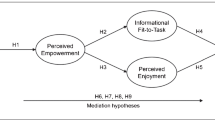Abstract
This study examines the trade-off between tailoring an ad to an individual consumer’s needs and the demand for personal data required to do so, which is inherent in targeted online advertising. Two scenario-based studies in two different industries reveal the extent to which using personal information with greater distinctiveness affects consumers’ sense of intrusiveness and purchase intentions. We also manipulate ad fit to each consumer’s needs and the presence of a discount to investigate whether feelings of intrusiveness mitigate the potential positive effects of fit and discount. Higher degrees of personalization, such as adding personal identification or transaction information to browsing data, increase feelings of intrusiveness, and negatively affect purchase intentions. These negative effects are not compensated for by offering discounts but can be partly mitigated by presenting an ad with a high fit to consumers’ current needs. The positive effect of tailoring the ad is weakened at higher levels of intrusiveness though. Furthermore, high fit may lead to not only higher purchase intentions but also higher perceived intrusiveness levels. Presenting a consumer with a customized ad can thus be a double-edged sword, leading to higher purchase intentions but also greater perceived intrusiveness, which then negatively affects purchase intentions.


Similar content being viewed by others
References
Bijmolt, T. H. A., van Heerde, H. J., & Pieters, R. G. M. (2005). New empirical generalizations on the determinants of price elasticity. Journal of Marketing Research, 42(2), 141–156.
Boris, C. (2012). Online ad spending to top print in 2012. Marketing Pilgrim, January 19. Available at http://www.marketingpilgrim.com/2012/01/online-ad-spending-to-top-print-in-2012.html. Accessed 18 September 2012.
Chellappa, R. K., & Sin, R. G. (2005). Personalization versus privacy: an empirical examination of the online consumer’s dilemma. Information Technology and Management, 6(2–3), 181–202.
Clee, M. A., & Wicklund, R. A. (1980). Consumer behavior and psychological reactance. Journal of Consumer Research, 6(4), 389–405.
Compeau, L. D., & Grewal, D. (1998). Comparative price advertising: an integrative review. Journal of Public Policy & Marketing, 17(2), 257–273.
Culnan, M. J. (1993). How did they get my name? An exploratory investigation of consumer attitudes toward secondary information use. MIS Quarterly, 17(3), 341–363.
Edwards, S. M., Li, H., & Lee, J.-H. (2002). Forced exposure and psychological reactance: antecedents and consequences of the perceived intrusiveness of pop-up ads. Journal of Advertising, 31(3), 83–95.
Fitzsimons, G. J., & Lehmann, D. R. (2004). Reactance to recommendations: when unsolicited advice yields contrary responses. Marketing Science, 23(1), 82–94.
Franke, N., Keinz, P., & Steger, C. J. (2009). Testing the value of customization: when do customers really prefer products tailored to their preferences? Journal of Marketing, 73(5), 103–121.
Goldfarb, A., & Tucker, C. (2011). Online display advertising: targeting and obtrusiveness. Marketing Science, 30(3), 389–404.
Greene, W. H. (2008). Econometric analysis (6th ed.). Upper Saddle River: Prentice-Hall.
Grewal, D., Monroe, K. B., & Krishnan, R. (1998). The effects of price-comparison advertising on buyers' perceptions of acquisition value, transaction value, and behavioral intentions. Journal of Marketing, 62(2), 46–59.
Helft, M., & Vega, T. (2010). Retargeting ads follow surfers to other sites. Available at http://www.nytimes.com/2010/08/30/technology/30adstalk.html. Accessed 29 August 2010
Lavy, S., Mikulincer, M., Shaver, P. R., & Gillath, O. (2009). Intrusiveness in romantic relationships: a cross-cultural perspective on imbalances between proximity and autonomy. Journal of Social and Personal Relationships, 26(6–7), 989–1008.
Li, H., Edwards, S. M., & Lee, J.-H. (2002). Measuring the intrusiveness of advertisements: scale development and validation. Journal of Advertising, 31(2), 37–47.
Mooradian, T. A. (1996). Personality and ad-evoked feelings: the case for extraversion and neuroticism. Journal of the Academy of Marketing Science, 24(2), 99–109.
Morimoto, M., & Chang, S. (2006). Consumers' attitudes toward unsolicited commercial e-mail and postal direct mail marketing methods: intrusiveness, perceived loss of control, and irritation. Journal of Interactive Advertising, 7(1), 8–20.
Okazaki, S., Li, H., & Hirose, M. (2009). Consumer privacy concerns and preference for degree of regulatory control. Journal of Advertising, 38(4), 63–77.
Simonson, I. (2005). Determinants of customers’ responses to customized offers: conceptual framework and research propositions. Journal of Marketing, 69(1), 32–45.
Steel, E. (2011). Using credit cards to target web ads. The Wall Street Journal, October 25. http://online.wsj.com/article/SB10001424052970204002304576627030651339352.html. Accessed September 18, 2012.
Tam, K. Y., & Ho, S. Y. (2006). Understanding the impact of web personalization on user information processing and decision outcomes. MIS Quarterly, 30(4), 865–890.
Thota, S. C., & Biswas, A. (2009). I want to buy the advertised product only! Journal of Advertising, 38(1), 123–136.
Tucker, C. (2011). Social networks, personalized advertising and privacy controls. Working Paper 4851-10, MIT Sloan School of Management, Cambridge, MA.
White, T. B., Zahay, D. L., Thorbjørnsen, H., & Shavitt, S. (2008). Getting too personal: reactance to highly personalized email solicitations. Marketing Letters, 19(1), 39–50.
Ying, L., Korneliussen, T., & Grønhaug, K. (2009). The effect of ad value, ad placement and ad execution on the perceived intrusiveness of web advertisements. International Journal of Advertising, 28(4), 623–638.
Author information
Authors and Affiliations
Corresponding author
Additional information
The authors thank VODW, Leusden, and the Customer Insights Center, Groningen, both in The Netherlands, for supporting this research project. They also gratefully acknowledge the three anonymous ML reviewers and the editor for their valuable comments.
Appendix: Examples of stimuli used in the studies
Appendix: Examples of stimuli used in the studies
Study 1: Offer with high fit using the person’s name

Study 2: Offer with low fit and discount, using transaction information

Rights and permissions
About this article
Cite this article
van Doorn, J., Hoekstra, J.C. Customization of online advertising: The role of intrusiveness. Mark Lett 24, 339–351 (2013). https://doi.org/10.1007/s11002-012-9222-1
Published:
Issue Date:
DOI: https://doi.org/10.1007/s11002-012-9222-1




